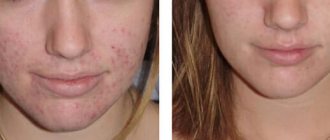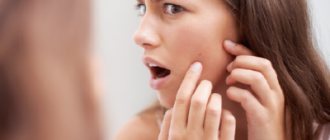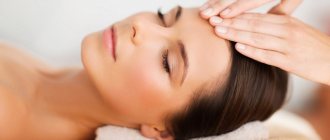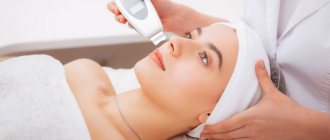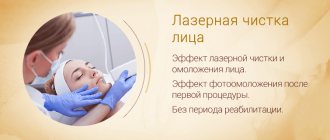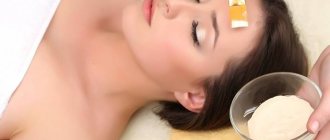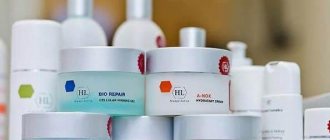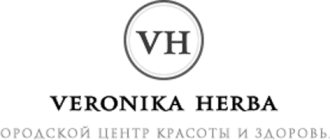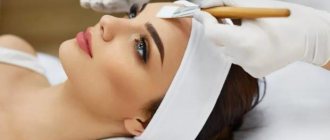The most popular facial cleansing is manual. It is not recommended to do it at home on your own, but many still neglect this rule. What is manual cleaning? Before starting, the skin is thoroughly steamed so that the pores open and are easily exposed. After this, the cosmetologist manually squeezes out the blackheads, thereby cleansing the skin. Next, the skin is disinfected and a mask is applied to it, which will help tighten the pores. It is worth noting that this procedure is effective, but very painful.
Mechanical cleaning is very similar to manual cleaning. Immediately before the procedure, the specialist applies a special warming mask to the skin. Pores are cleaned using a special spoon. The duration of the procedure is approximately 1 hour.
You can get rid of old skin particles using chemical peeling. A solution of special acids will be applied to your face, after which your skin can be compared to the skin of a baby. It is noteworthy that this type of peeling is available to many, because its prices are affordable.
If you are the “lucky” owner of oily skin, then ultrasonic facial cleansing is ideal for you. The skin is cleansed using special sound vibrations. The result, which will undoubtedly please you, will last for a long time. By the way, if you have any skin diseases, then you cannot use this method.
Any salon facial cleansing should be done before the weekend, since after it you shouldn’t apply makeup for a couple of days, and you will really want to do this, because your facial skin will be unnaturally reddish.
How to cleanse your face at home?
The easiest and cheapest way is cosmetic clay, which can be bought at any pharmacy. For oily skin, choose green, white and blue clay. If you have dry skin, then you need to buy red clay. Black clay is suitable for any skin type. This product must be diluted with water (preferably mineral water). The consistency of your mask should resemble a thin porridge. Keep this mask for 15 minutes, then rinse with warm water and apply moisturizer. Remember that no powder or foundation can give you the same effect as regular facial cleansing.
Among common cosmetic procedures, one of the leading places is occupied by cleansing the skin of excess impurities and dead cells. Facial cleansing, the prices of which are kept within moderate limits, is performed for hygienic purposes, in addition, it stimulates metabolic processes, nutrition and blood supply in the upper layers of the skin. The procedure is recommended for both men and women, starting from the age of puberty.
How to cleanse different skin types?
In order to cleanse your facial skin properly and maintain its health and youth, you need to choose special cosmetics for washing that are suitable specifically for your skin type.
After all, insufficient cleansing can lead to clogged pores and the appearance of acne. And too zealous cleansing can disrupt the skin's hydrolipid mantle and lead to dehydration. Therefore, choose cosmetics from reliable brands and be sure to pay attention to the label; most products indicate what type of skin it is intended for.
Oily skin
Oily skin types are characterized by enlarged pores, increased sebum production and a greasy shine. That is why cleansers should have a sebum-regulating function, tighten pores, clean thoroughly, but at the same time provide the skin with moisture and not dry it out. Oily skin, like any other, needs hydration.
For such facial skin, cosmetics containing thermal water, kaolin and zinc are well suited. Keep in mind that the composition should not contain ethyl alcohol!
Dry skin
Dry skin is usually quite thin and sensitive, it requires gentle and careful cleansing. Cleansers for dry skin types should be gentle and softening, have restorative functions, and should not contain alcohol. Most often these are creams, mousses or foams.
The exfoliation procedure should be approached with caution and the means chosen wisely. Scrubs with rough abrasive particles can damage dry skin.
Normal skin
Lucky people with normal skin type have the widest choice among cosmetics. They are not limited by either product types or textures. Suitable products must be labeled “for normal skin” or “for all skin types.”
Combination skin
Those with combination or mixed skin types will have to adapt when looking for cleansers. This is necessary so as not to harm the already dry areas of the skin in the U-zone. If after washing your face there is a feeling of tightness, then the product is not suitable for you. It is better to stick to products for dry or normal skin types.
Facial cleansing: different types
- combined
- mechanical;
- ultrasonic;
The type is selected after consultation with a doctor, during which the specialist, based on the characteristics of the skin and individual indications, chooses the most effective method of treatment. Ultrasonic facial cleansing is recognized as the most effective.
Indications for ultrasonic facial cleansing:
- sebaceous glands with enlarged pores;
- comedones;
- a large number of acne in the healing stage;
- combination and aging skin;
- lack of skin tone.
Contraindications:
- eczema;
- herpes;
- severe hypertension;
- epilepsy;
- diabetes;
- mental disorders.
Why do you need to cleanse your face?
The skin is the largest organ of the human body, which ensures its respiration, metabolic processes, and also protects against the penetration of infections. However, people's facial skin varies, and depending on its oil content, both the sebaceous and sweat glands, which are abundantly located in the thickness of the layers of the skin, function differently.
Methods for cleaning leather in the salon
Cosmetologists also offer a list of aesthetic procedures aimed at deep cleansing and renewal of the epidermis, for example, chemical and hardware exfoliation of the facial skin. Such procedures involve the use of acids and enzymes that literally dissolve the stratum corneum of cells.
Important(!):
After chemical or acid peeling, the photosensitivity of the skin increases. Be sure to use a daily sunscreen with at least SPF 30 to prevent photoaging.
The most popular salon procedures for deep cleansing of facial skin:
- Ultrasonic cleansing (ultrasonic peeling) – cleansing pores of excess sebum and dead cells by exposure to ultrasonic waves.
- Vacuum cleaning is a gentle hardware method of cleansing the skin. The procedure effectively cleanses pores, gets rid of blackheads, and tightens the oval of the face due to the lymphatic drainage effect.
- Mechanical (manual) cleaning is the most traumatic and effective procedure for cleansing clogged pores. A classic option for cleansing the skin using a loop spoon (UNO).
- Galvanic (disincrustation) cleansing is suitable for thick, oily skin: a salt solution is used and microcurrents are applied to the skin. As a result of the procedure, the pores are cleaned, blackheads and comedones disappear.
- Microdermabrasion (resurfacing) is aimed at intensive renewal of the epidermis and smoothing out stagnant spots (post-acne).
Ultrasonic cleaning
Description of the procedure
To carry out ultrasonic cleaning, a special ultrasonic device is used. During this procedure, the face is exposed to ultrashort waves that penetrate deeply into the skin and provide micromassage to the tissues. Indications for ultrasonic cleaning are the same cases of clogged pores and non-inflamed acne.
Ultrasonic cleaning does not harm the skin at all. The influence of ultrasound not only deeply cleanses the skin of toxins, impurities, sebum and blockages of the sebaceous glands, but also during ultrasonic facial cleansing, micromassage of the skin is performed and smoothing out fine wrinkles.
Ultrasonic cleaning is good because it is non-traumatic and absolutely painless, leaving no marks or redness.
Preparation
Before ultrasonic cleaning, the skin must be cleaned of makeup, dust, and dirt using regular cleansers depending on the skin type. Then a special tonic or gel is applied to the skin, which, when exposed to ultrasound, will cause old cells to peel off.
Carrying out the procedure
When carrying out ultrasonic cleaning, the cosmetologist moves the tip of the ultrasonic device over the face. At the same time, the entire upper dead layer of skin is exfoliated, impurities, makeup residues, and waste products of the glands come out of the pores to the surface. All this dirt is immediately removed by a cosmetologist. As a result, the skin looks younger and fresher, because ultrasonic cleansing of the skin also causes superficial peeling.
With ultrasonic facial cleansing, the skin not only becomes fresher, but also becomes healthier. After cleansing, pores are reduced, scars heal faster and skin irritation goes away. Skin oiliness is noticeably reduced due to exposure to ultrasound, so those with dry skin should continue to use various moisturizing creams and masks.
The procedure is performed without preliminary steaming of the skin, which is suitable for skin with vascular mesh.
The final stage
If your facial skin has a lot of clogged pores, comedones, etc., then gentle ultrasonic cleansing will not give a 100% result and will have to be supplemented with manual intervention. However, in all other cases, ultrasonic cleaning maintains youthful and toned skin. If mechanical cleaning is carried out after ultrasonic cleaning, then the already described procedures are carried out to soothe the skin. If cleaning is limited to exposure to ultrasound, then after this there is no need to further soothe the skin, however, the renewed cells will gratefully accept a variety of cosmetic care procedures.
At the same time or after ultrasonic cleaning, it is advisable to carry out ultraphonophoresis, that is, the introduction of various nutritional preparations into the skin.
Why you need to cleanse your face regularly
Every day, impurities accumulate on the surface of the skin and in the pores: dust, decorative cosmetics, sebum, dead skin particles and even remnants of care products. In order to get rid of them, you have at least two reasons:
- They provoke inflammation. An explosive mixture of pollution is an ideal breeding ground for the development of bacteria and, consequently, the occurrence of acne.
- They reduce the effectiveness of skincare products. It is difficult for beneficial components to break through the “mask” of impurities, so creams and serums cannot show their full potential.
- How to understand that your skin lacks cleansing? Believe me, she will “tell” about it herself! Or, more precisely, it will show in the mirror.
Signs of dirty skin
Healthy, clean skin should look smooth, hydrated and radiant (not to be confused with “shiny with oil”). If yours is still far from this ideal, look for the main signs of contamination:
- A scattering of small pimples.
- Dull complexion.
- Black dots.
- Enlarged pores.
- Uneven terrain.
Peeling
All peeling products can be divided into 3 main groups according to their mechanism of action:
- Mechanical peeling (manual peeling, hardware peeling, micro-polishing);
- Physical peeling (ultrasonic peeling, laser peeling);
- Chemical peeling (based on the use of different substances).
In addition, peeling methods should be distinguished by the degree of “aggression” (depth of penetration into the skin layers):
- exfoliation, i.e. exfoliation of the stratum corneum;
- epidermolysis, i.e. superficial peeling procedure;
- medium peeling
- deep peeling
Superficial peeling
Superficial peeling affects only the upper layer of the epidermis - from horny to granular. It is recommended to prevent skin aging. Superficial peeling evens out the surface of the skin, improves the color and texture of the skin: pores narrow, wrinkles become less noticeable. In this case, only the horny cells of the epidermis are exfoliated. A peeling course consists of 5–7 procedures, the interval between which is a week. The very next day you can use cosmetics. For the procedure, fruit (alpha hydroxy) acids of varying concentrations are used, which depends on the type and condition of the skin (determined by the doctor).
Superficial peeling is the most gentle compared to medium and deep peeling. Its essence is damage, creating a burn surface on the skin. An acid of a certain concentration and strictly in time is applied to cleansed skin with a brush. The deeper the peel, the stronger the acid used and the more difficult the procedure.
Soft: the stratum corneum is destroyed to the granular layer (stratum granulosum). These include: Jessner solution, CO2, dry ice, fruit acids 20-70%, trichloroacetic acid 15%.
Superficial peeling is performed without anesthesia and is accompanied by severe redness of the skin, itching and peeling. Feeling as if someone walked over the face with a pumice stone. In the coming days, the skin begins to peel off and dry crusts appear.
At this time, the skin is treated with special products and wound-healing medications. The success of the procedure largely depends on skin care after the procedure. It is very important not to peel off the crusts and husks until they come off on their own. For a certain period of time, you should not appear in the sun, much less sunbathe, otherwise age spots will appear on your face, which are very difficult to eliminate. The remission period is 2-3 weeks.
Facial cleansing with fruit and other acids is essentially an exfoliation. These procedures are used after mechanical or hardware facial cleansing to smooth out the skin texture and remove dead cells.
If there is acne on the skin (not in the inflammatory phase!), then you can use superficial acid peeling to remove plugs from the pores. Chemical peeling with fruit acids refreshes the skin and cleanses surface impurities, but does not reach deep-lying inflammations.
In these cases, chemical peeling can only be the final stage after mechanical and other cleaning methods. The peeling procedure can be called “aggression for good.” The ability to regenerate is the most important property of the skin, without which it could not act as a barrier between the body and the external environment. The slightest breach in it can become fatal, so the reaction to damage occurs immediately. A signal for restoration work is any traumatic impact: a scratch, abrasion, burn, exfoliation of horny scales, etc.
Fruit peeling is a gentle facial cleansing that gently cleanses the skin of dead cells and toxins. Thanks to a gentle technique, this type of peeling can be used without any age restrictions, which makes it possible to prevent the formation of wrinkles at the very initial stages, improve the functioning of the sebaceous glands, the process of skin regeneration, and also stimulate the synthesis of collagen fibers, which are responsible for the elasticity and smoothness of the skin. Cosmetology specialists recommend fruit peeling for facial skin with signs of photoaging, since this procedure has not only a smoothing, but also a brightening effect. In order for the effectiveness of such peeling to be maximum, it is necessary to follow several simple rules.
The most important thing, of course, is to follow the advice of a cosmetologist who conducts a series of peeling sessions, the number of which can vary from 4 to 10 depending on the method of implementation, the concentration of the active substance and the condition of the skin. And also remember that for 30-40 days after and directly during the procedure, sunbathing is strictly contraindicated, and even better, constantly use sunscreen with a high degree of protection.
It should also be understood that such peeling does not give an immediate effect, and its positive effects appear gradually. That is, every day your facial skin will become younger and healthier. The process of gently cleansing the skin of the face itself is based on the action of AHA acids, which, due to their natural origin, are known in the same way as fruit acids. Although today these substances can also be obtained artificially, which does not make them less effective. The most commonly used are citric, glycolic, lactic, tartaric and malic acids.
Each of them has its own characteristics, but many cosmetologists believe that the best peeling is glycolic. This is explained by the fact that the molecular sizes of this acid are much smaller than others, which guarantees a deeper penetrating effect. Most specialists use a mixture of several acids.
Also, AHA acids, for a more pronounced and lasting effect, are combined with other substances, for example, vitamins A, E, salicylic acid (for deeper cleansing), etc.
The fruit peeling procedure is a seemingly simple process, but it requires specific knowledge, skills and experience. Therefore, it is better to trust its implementation to experienced professionals who have positive recommendations and characteristics.
Main signs of contaminated skin
The epidermis of the face is the most vulnerable and unprotected area of the skin, constantly in contact with the external environment and exposed to its negative influences. During the day, a lot of contaminants accumulate on the surface of the face: particles of dust, precipitation, gases, remnants of decorative cosmetics and care products, sebum, dead cells. Insufficient cleansing can cause deterioration of the skin condition.
The first signs of epidermal contamination:
- Dull, uneven skin texture.
- Enlarged pores, feeling of an oily film on the face.
- An abundance of blackheads, small pimples, comedones.
When these symptoms occur, the usual washing becomes insufficient, and the beauty routine must be supplemented with the obligatory stage of deep cleansing of the facial skin.
Summer peelings (all-season)
Summer peels are a very demanding procedure for post-peeling care. Because in summer the sun is very active. Accordingly, most peels cannot be done in the summer, while others can be done under certain conditions, and only with proper post-peeling care.
The main recommendation when carrying out peelings is to avoid periods of increased solar activity, because... the protective layer of the skin becomes thinner. Which leads to increased sensitivity to ultraviolet radiation.
Also, when the upper layers of facial skin are damaged, cells producing the melanin pigment are activated, and this leads to the risk of pigmentation disorders.
For people with a seborrheic constitution, with thick, porous and oily skin, regular peeling is recommended, even in summer. This helps them maintain healthy looking skin. And for this, the most superficial peeling (at the level of the stratum corneum) is sufficient, without affecting the skin barrier.
In these cases, preparations with AHA acids in low concentrations, salicylic, lactic, almond or ferulic peels are sufficient. There is also a need to prescribe deeper peels. These are chrono- and photoaging, rosacea, acne and post-acne. And for many people, summer, as the holiday season, is the only opportunity to conduct a peeling course.
Concluding the above, it should be noted that it is very important during the period of peeling in the summer and for 3-4 weeks afterward, you must constantly use sunscreen with a protection factor of at least 30, and in some cases even 50. Do not sunbathe during periods of active sun, do not visit the solarium and, under no circumstances, do not get sunburned. Remember that sunscreens wash off with water, even waterproof ones must be reapplied several times a day.
Which cleaning is more effective? Depends on skin condition and type
Mechanical (also known as manual) – for oily skin prone to inflammation
How it’s done: dirt is scraped out of the pores manually using a Uno spoon or strainer.
Advantages:
- effective in the fight against acne;
- removes excess fat;
- copes with dense blockages;
- improves blood circulation.
Disadvantages: the most painful and lengthy cleaning option.
Read more about mechanical facial cleansing
Ultrasonic (aka ultrasonic cleaning) – for dry and sensitive skin
How it is carried out: contaminants are removed with an ultrasonic emitter-scrubber.
Advantages:
- cleans without damage;
- improves skin tone;
- cleanses and tightens pores;
- removes excess fat without injury;
- stops inflammation.
Disadvantages: does not cope with rashes.
Read more about ultrasonic facial cleansing
Atraumatic – for irritated and inflamed skin
How it is carried out: the skin is cleansed with a delicate peeling, then a series of care products is applied.
Advantages and features:
- does not damage the skin;
- does not irritate the skin by physical impact;
- reduces acne;
- removes pigmentation;
- tightens pores;
- evens out facial tone;
- smoothes the relief;
- can be combined with vacuum cleaning and RF lifting.
Disadvantages: Maintains skin quality, but does not treat clogged pores.
Combination – for mixed skin types with localized rashes
How it is carried out: combines mechanical and ultrasonic techniques.
Advantages and features:
- can be used for any skin type;
- less damaging to the skin compared to mechanical cleaning;
- reduces the risk of infection;
- shortens the recovery period;
- allows you to adjust the intensity of exposure in different areas.
Disadvantages: requires the experience and attention of a cosmetologist to obtain maximum effectiveness.
Read more about combined facial cleansing.
Mandelic acid
40% mandelic acid.
The most gentle acid that can be used even by teenagers over 10 years old. It is used for very sensitive skin, can be done in the summer, and also as a preparatory peeling (pre-peeling preparation) for a subsequent course of other acids. This is a specific treatment, indicated for all skin types, also for very sensitive and thin skin, does not create any aesthetic discomfort and gives visible and long-lasting results.
Indications:
- hyperpigmentation
- treatment of mild acne
- comedones
- treatment of rosacea (even acute phases)
- at all stages of demodicosis (as an addition to treatment)
Results:
Immediate improvement:
The skin glows from the inside, becomes polished, and acquires a beautiful color. Can be done before and after tanning in a solarium or in the sun, before applying makeup.
Almond care No. 1 is aimed at structural rejuvenation of the skin. Leads to noticeable improvements in the appearance of the skin. — Improves and makes the tan more even.
- Strengthens the skin's immune system.
- Protects cell DNA.
- Removes the first signs of inflammatory erythema and reduces the effects of free radicals.
Strengthens the skin barrier.
Frequency of the procedure:
1 time per week up to 10 procedures. Alternation with INTERACTIVE CARE is possible.
Almond care No. 2 for facial skin with pigmentation problems: aimed at structural rejuvenation of the skin. Leads to noticeable improvements in the appearance of the skin.
- Strengthens the skin's immune system.
- Protects cell DNA.
- Removes the first signs of inflammatory erythema and reduces the effects of free radicals.
- Strengthens the skin barrier, facial skin becomes less susceptible to aggressive environmental factors.
FREQUENCY: 1 time per week, up to 10 procedures.
How to properly carry out daily cleansing: instructions
Facial cleansing is the longest and most important skin care procedure that is performed at home and depends on you. It consists of several basic stages.
Preparation or makeup removal
The stage of removing surface impurities that have accumulated on the surface of the skin during the day or night.
Many people neglect morning cleansing, believing that the epidermis did not have time to get dirty overnight. While we sleep, the body's metabolic processes are continuously working, internal cleansing and cell restoration occur. For example, the peak of sebum production occurs at 4–5 o'clock in the morning, so it is important to take care of cleansing the facial skin twice a day (more often it is not recommended so as not to damage the hydrolipid mantle).
The following products are suitable for makeup removal:
- micellar water (for all skin types);
- milk (for dry and sensitive types);
- cleansing lotion (often does not require rinsing with water);
- Makeup remover wipes (travel version).
Washing (basic cleansing)
The second step is to wash your face with water and cleanser. At this stage, you need to cleanse the facial skin of any remaining impurities dissolved in the first stage and completely empty the pores.
There are special products for washing:
- for oily and combination skin – foams with a sebum-regulating effect, facial gels + “2 in 1” scrub;
- for sensitive people – soft mousses, foams;
- for dry and dehydrated skin – moisturizing and softening milk, cream, balm.
Apply a small amount of product to damp facial skin. Then use gentle circular movements with your fingertips to massage the entire surface of your face, avoiding the eye area. Finally, rinse off the cleanser with water and pat your face dry with a clean, soft towel.
Moisturizing and toning
The final, but not the last most important stage of cleansing is skin moisturizing. After washing your face, wipe your dry face with a cotton pad soaked in a toner with a moisturizing formula. This will restore the pH balance of the epidermis, prepare for the further corrective stage of care and improve the penetration of beneficial components from care cosmetics into the deep layers of the skin.
Complications arising during the rehabilitation period
Post-inflammatory pigmentation
Uneven pigmentation can occur in response to any deep damage to the skin. Exposure to the sun without sunscreen increases pigmentation.
Exacerbation of acne
Patients with seborrhea (oily skin) or acne may develop rashes 2-4 weeks after the procedure.
Wide pores
Chemical peels can stimulate pore enlargement. This most often occurs in people with thick skin. Enlarged pores appear 3-4 weeks after the procedure, and disappear at 6-10, since by this time new collagen fibers are formed.
Persistent increase in facial skin sensitivity
When performing deep peels on people with thin, dry, sagging skin, sensitivity may increase. This condition can last from several weeks to several months and is accompanied by redness of the skin.
Late complications
- Hypertrophic reactions (uneven thickening of the skin)
- The upper lip, cheeks, and lower eyelids are most susceptible to these complications; this is especially common with deep peels.
- The development of hypopigmentation (areas of skin lacking pigment) depends on the depth of peeling. Most often occurs after phenol and deep TCA peels.
- Patients with thin, sensitive skin are at risk of developing this complication.
It must be said that it is not enough to have the procedure done in a clinic; it is also important to properly care for your facial skin during its recovery period.
Post-peeling care includes the use of cosmetics containing antioxidants and wound-healing components (vitamin A, E, F, panthenol), moisturizers (hyaluronic acid), products that soften and restore the structure of the barrier (lipid) membrane (shea butter, vegetable and mineral oils ). The use of photoprotective products is mandatory. It is necessary to avoid exposure to the sun (solarium, beach tanning). For medium peels, you should initially refrain from visiting the bathhouse or sauna.
Scrubs for deep skin cleansing
Try homemade scrub recipes based on natural ingredients - it's simple, healthy and economical:
- Semolina scrub
– the particles of semolina are quite small and not sharp, which allows you to use semolina as a base for all kinds of homemade scrubs. The easiest option is to mix semolina with heavy cream or sour cream;
- Oatmeal scrub
– in this case, the oatmeal will first have to be ground with a coffee grinder. Oatmeal-based scrubs are very gentle and ideal for sensitive facial skin. You can mix ground oatmeal with sour cream, whipped egg white or natural yogurt, but you need to start the procedure immediately, since the grain particles swell quickly;
- Coffee scrub
– natural ground coffee is also perfect as a base for homemade scrubs. Particularly good options: coffee + banana pulp and coffee + full-fat cottage cheese. These products are very easy to use and at the same time beneficial for facial skin of any type;
- Sugar scrub
– preferable for cleansing dry facial skin. Fine sugar is mixed with sour cream, cottage cheese, avocado or banana pulp. Such compositions must be used immediately after preparation, since sugar melts quickly;
- Honey-salt scrub
– is more suitable for those with oily facial skin, but if you use it on the body after a bath, then it is simply a fairy tale for any skin type. A facial scrub is prepared from a tablespoon of honey and half a teaspoon of finely ground salt, and for the body choose coarser table salt or better sea salt, approximately maintaining the above proportions;
- Egg shell scrub
– best copes with the problem of flaky facial skin. The shells of several eggs must be ground very thoroughly with a coffee grinder, literally “into dust.” Then we will get small, dense particles that perfectly remove the stratum corneum of the skin without injuring it. You can mix ground shells with any of the above bases, but best of all – with full-fat cottage cheese and cream;
- Almond-orange scrub
– the most fragrant and pleasant to use homemade scrub recipe. Grind a handful of almonds with a coffee grinder to a crumb size of 1-2 mm in diameter, then add a little freshly squeezed orange juice (or preferably lemon juice if your skin is very oily) and easily massage your face with this mixture for a few minutes.
It is recommended to use natural scrubs for deep cleansing of the skin, regardless of its type, more often than 1-2 times a week. Take care of yourself and be beautiful!
Author of the article:
Kuzmina Vera Valerievna |
Endocrinologist, nutritionist Education: Diploma of the Russian State Medical University named after. N.I. Pirogov, specialty “General Medicine” (2004). Residency at the Moscow State Medical and Dental University, diploma in Endocrinology (2006). Our authors
Indications and contraindications
The content of the article
Before you carry out cleaning yourself, you need to make sure that it is really necessary and that there are no contraindications.
It's time to peel if:
- age-related changes have appeared (wrinkles and sagging);
- there are various rashes (acne and pimples);
- I want to get rid of small scars, stretch marks and cicatrices;
- irregularities, pigment spots and roughness appeared;
- complexion has become uneven or sallow.
The procedure is strictly prohibited if:
- the presence of a large number of moles or if there is a birthmark;
- herpes;
- allergic rashes;
- dermatitis;
- eczema;
- tendency to develop scars;
- psoriasis.
It is also not recommended to cleanse the face for those suffering from cardiovascular diseases, epilepsy and bronchial asthma.
Even more inflammation after cleansing: two reasons
- Infection during the procedure
Facial cleansing should be performed in a treatment room where aseptic and antiseptic standards are observed. This is especially important for mechanical cleaning, which disturbs the skin.
- The cosmetologist must work in a cap, mask and sterile gloves. The mere presence of gloves does not equal sterility. Gloves should be removed from the sealed packaging in front of the patient at the beginning of the procedure.
- Instruments must be sterilized after each patient.
- The office must be disinfected after each patient.
- A cosmetologist should have alcohol wipes in his arsenal. After opening each source of inflammation, the skin and instruments should be treated with an antiseptic.
If these measures are not followed, then bacteria from one pimple or from the hands of a cosmetologist can spread throughout all freshly cleaned pores and cause widespread inflammation.
- Infection after the procedure
Most often, the infection is introduced into wounds and pores by the hands of a patient who can’t wait to touch his renewed face.
In the first 8 hours after cleansing, you should not wash or touch the skin, as it needs to restore the protective barrier - this is a mandatory recommendation that every cosmetologist gives at the end of the appointment.
To prevent skin inflammation after cleansing, follow the care recommendations and trust the procedure only to certified clinics.

